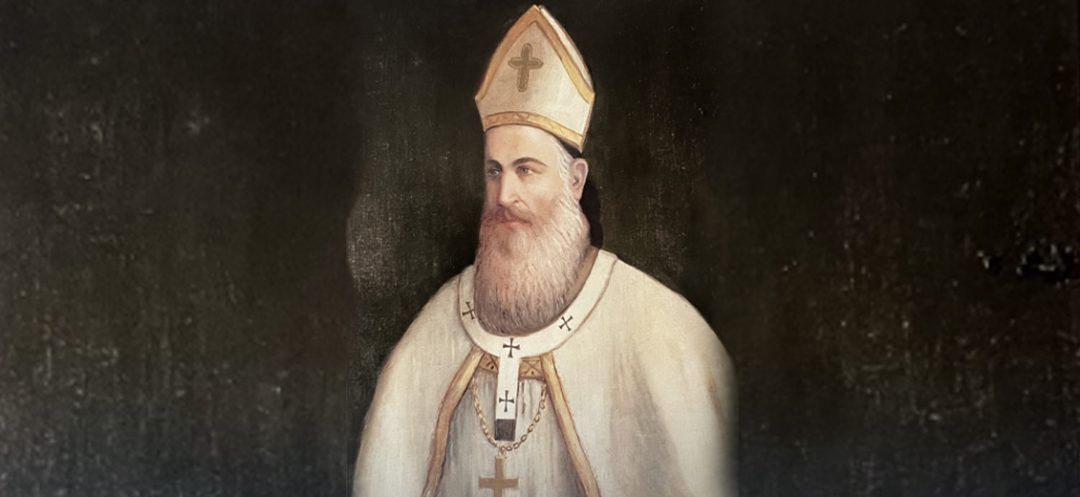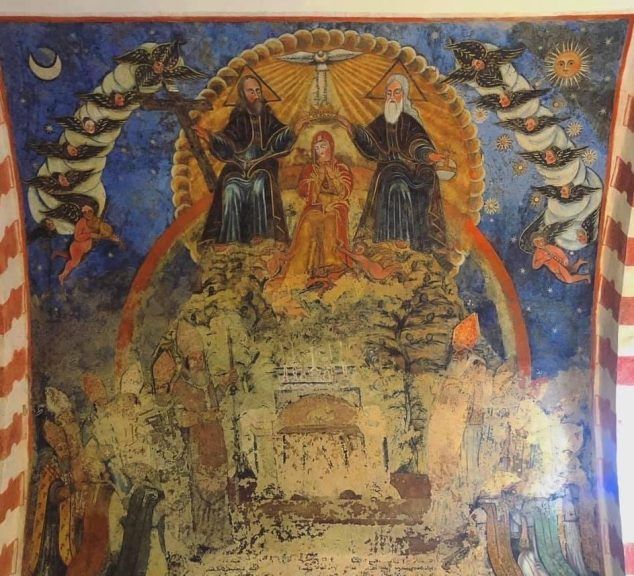
Estephanos Doueihi initiated a liturgical and cultural reform that reconnected with Antiochian roots while upholding allegiance to Rome, within a Syriac-Latin syncretism that confirmed his Chalcedonian and Catholic identity. He perceived the Maronite culture as a synthesis of Syriac poetic expression and Western positivist philosophy.
A thousand years after Saint John Maron, the reforming patriarch Estephanos Doueihi was officially recognized as venerable by the Catholic Church on July 3, 2008. This recognition paved the way for Benedict XVI to approve the initiation of his canonization process.
Pope Francis declared him blessed, and he will be beatified in Bkerke on August 2, his feast day. The following day, a mass will be celebrated in his hometown of Ehden. The two greatest leaders of the Maronite Church will thus be honored as saints by the universal Church.
History of the Times
His second major work, after The Candelabra of the Holy Mysteries, is titled The History of the Times. It spans from the year 622 to 1704 and covers Syria-Mesopotamia, Egypt, Asia Minor and Ottoman-occupied Eastern Europe. It consists of two texts: the first, The History of the Christians, covers the period from 1095 to 1699, while the second, The History of the Muslims, extends from 622 to 1686.
As a clear reference to William of Tyre and Jacques de Vitry, Estephanos Doueihi detailed how the Maronite warmly welcomed the Franks, their prowess as exceptional archers and the prosperity of Mount Lebanon during that time. He later elaborated on the cataclysm and desolation that befell their mountains with the fall of the Latin states in the Levant. He provided extensive information and details about the cruelty of the Mamluks and the natural disasters that ensued, including earthquakes, insect invasions, epidemics, hailstorms and droughts, which caused famines and decimated the population of Mount Lebanon.
In his accounts of the Maronites' redeployment following the genocide perpetrated by the Mamluks, the patriarch detailed the true history of some native families who later claimed Arab ancestries. Doueihi shared details about their deeply local origins and the circumstances that compelled them to adopt Arabic names to ensure their safety.
He frequently drew upon his historical knowledge in his correspondences to France. On October 25, 1671, in a letter to Bonnecorse, the French consul in Sidon, he discussed the French-Maronite relations dating back to Godfrey of Bouillon and Saint Louis. On March 20, 1700, in a letter to Louis XIV, he reported on the suffering of Christians and the persecution they were enduring.
Doueihi is hailed as the father of Maronite history. Monsignor Pierre Shebli noted that without him, "We would have been the most unfortunate community, ignorant of our past, our origins, our ancient beliefs and the trials of our destiny."

Literature
In addition to his major encyclopedic works, The Candelabra of the Holy Mysteries and The History of the Times, Doueihi authored The Book of Syriac Anaphoras, in which he compiled the 31 anaphoras acknowledged by the Maronite Church. He categorized them and provided biographies of their respective authors.
In The Book of Rich-qole (tonus princeps or Syriac poetic strophes), he compiled the standard stanzas and their poetic models, covering the entire Maronite tradition. He classified them according to the meters of Saint Jacob (yaacuvoyo), Saint Ephrem (Ephremoyo) and Saint Balai. He also contributed to the versification of Maronite Syriac music, composing versified poems that were set to music and sung according to tradition. He also wrote The Book of Prayers, which he titled Ktovo da slaoto, and which some have identified with the Shhimto. He is also the author of several other works, including: The Sermons, The Ceremony of the Cloak, The Prayer of Saint Marina, The Biography of the Saints, The Book of Requiems and The Seven Sacraments of the Church.
Furthermore, Estephanos Doueihi compiled administrative and economic records, translated papal bulls addressed to the Maronites and worked on an Arabic-Syriac dictionary that has unfortunately since been lost. Furthermore, he created a 770-page register bearing his name. He drafted a list of Maronite patriarchs from Saint John Maron, as well as the history of the mqaddam (leaders) of the Gebbe from 1382 to 1690.
Doueihi also copied important works, including the Book of Siome (impositions of hands, which details the ceremonies of ordination of priests). He included three versions composed by Patriarch Jeremiah of Amshit (1199-1230), Priest Marcos Limtaos (1495) and Monk Habacuc of Adnit (1581).
Patriarch Estephanos Doueihi was the first to delve into epigraphy, recording and translating inscriptions carved into rocks. In Gosta, he deciphered the Syriac epitaph of his predecessor, George of Bsebeel (1670), engraved in the rock. In 1684, he translated the inscription of Marcus Aurelius on the steles of Nahr al-Kalb.
[readmore url="https://thisisbeirut.com.lb/lebanon/273960"]
Renaissance
His work initiated a liturgical and cultural reform that reconnected with Antiochian roots, aiming to revitalize Syriac culture and language while upholding allegiance to Rome.
This resulted in a Syriac-Latin syncretism that affirmed its Chalcedonian and Catholic identity.
He worked to counteract the excessive Latinization imposed by his predecessor, Gabriel Barcleius (1447-1516), on the Maronite episcopal seat of Cyprus. Estephanos Doueihi opted to return to Syriac roots, drawing on the influential traditions of Saint Ephrem and Saint Jacob of Sarug. This approach led to a local renaissance that reinforced the revival of authentic traditions.
To him, the Western discipline inherited from the ancient Greeks offered a counterbalance to the Eastern tendency toward spontaneity and mysticism. He perceived the Maronite culture as a synthesis between Syriac poetic expression and Western positivist philosophy. Reflecting the ideals of the College of Rome where he studied, Estephanos Doueihi longed for a Maronite renaissance that would extend beyond Lebanon and reach the Maronites in Cyprus, Syria, Galilee and Malta.
Identity
In his quest to shed light on the identity of the Maronite Church, he consistently emphasized its Antiochian apostolic nature, its Syriac culture and language, its Chalcedonian faith, its Catholic affiliation and its monastic tradition.
His ultimate masterpiece was the fresco of the Coronation of the Holy Virgin in the rock-hewn church of Qannoubine. Through this creation, he crafted his manifesto of the sacred homeland by depicting Mary, Queen of Lebanon, being crowned by the Father, the Son and the Holy Spirit amidst the ancient cedar forest. At her feet, Maronite patriarchs in ceremonial robes parade with gifts. Lebanon is anointed to the Mother of God, symbolizing a profound harmony between the mountain and Christianity. This was Estephanos Doueihi’s vision and a reflection of the founding patriarch, Saint John Maron.
He passed away in Qannoubine, as he had wished, on May 3, 1704, before completing the fresco, and was buried in the cave of Saint Marina. His successor, Gabriel of Blaouza, wrote, "The lily has withered, the rose has faded; the teachings have concluded, and holiness has reached its perfection."
A thousand years after Saint John Maron, the reforming patriarch Estephanos Doueihi was officially recognized as venerable by the Catholic Church on July 3, 2008. This recognition paved the way for Benedict XVI to approve the initiation of his canonization process.
Pope Francis declared him blessed, and he will be beatified in Bkerke on August 2, his feast day. The following day, a mass will be celebrated in his hometown of Ehden. The two greatest leaders of the Maronite Church will thus be honored as saints by the universal Church.
History of the Times
His second major work, after The Candelabra of the Holy Mysteries, is titled The History of the Times. It spans from the year 622 to 1704 and covers Syria-Mesopotamia, Egypt, Asia Minor and Ottoman-occupied Eastern Europe. It consists of two texts: the first, The History of the Christians, covers the period from 1095 to 1699, while the second, The History of the Muslims, extends from 622 to 1686.
As a clear reference to William of Tyre and Jacques de Vitry, Estephanos Doueihi detailed how the Maronite warmly welcomed the Franks, their prowess as exceptional archers and the prosperity of Mount Lebanon during that time. He later elaborated on the cataclysm and desolation that befell their mountains with the fall of the Latin states in the Levant. He provided extensive information and details about the cruelty of the Mamluks and the natural disasters that ensued, including earthquakes, insect invasions, epidemics, hailstorms and droughts, which caused famines and decimated the population of Mount Lebanon.
In his accounts of the Maronites' redeployment following the genocide perpetrated by the Mamluks, the patriarch detailed the true history of some native families who later claimed Arab ancestries. Doueihi shared details about their deeply local origins and the circumstances that compelled them to adopt Arabic names to ensure their safety.
He frequently drew upon his historical knowledge in his correspondences to France. On October 25, 1671, in a letter to Bonnecorse, the French consul in Sidon, he discussed the French-Maronite relations dating back to Godfrey of Bouillon and Saint Louis. On March 20, 1700, in a letter to Louis XIV, he reported on the suffering of Christians and the persecution they were enduring.
Doueihi is hailed as the father of Maronite history. Monsignor Pierre Shebli noted that without him, "We would have been the most unfortunate community, ignorant of our past, our origins, our ancient beliefs and the trials of our destiny."

Literature
In addition to his major encyclopedic works, The Candelabra of the Holy Mysteries and The History of the Times, Doueihi authored The Book of Syriac Anaphoras, in which he compiled the 31 anaphoras acknowledged by the Maronite Church. He categorized them and provided biographies of their respective authors.
In The Book of Rich-qole (tonus princeps or Syriac poetic strophes), he compiled the standard stanzas and their poetic models, covering the entire Maronite tradition. He classified them according to the meters of Saint Jacob (yaacuvoyo), Saint Ephrem (Ephremoyo) and Saint Balai. He also contributed to the versification of Maronite Syriac music, composing versified poems that were set to music and sung according to tradition. He also wrote The Book of Prayers, which he titled Ktovo da slaoto, and which some have identified with the Shhimto. He is also the author of several other works, including: The Sermons, The Ceremony of the Cloak, The Prayer of Saint Marina, The Biography of the Saints, The Book of Requiems and The Seven Sacraments of the Church.
Furthermore, Estephanos Doueihi compiled administrative and economic records, translated papal bulls addressed to the Maronites and worked on an Arabic-Syriac dictionary that has unfortunately since been lost. Furthermore, he created a 770-page register bearing his name. He drafted a list of Maronite patriarchs from Saint John Maron, as well as the history of the mqaddam (leaders) of the Gebbe from 1382 to 1690.
Doueihi also copied important works, including the Book of Siome (impositions of hands, which details the ceremonies of ordination of priests). He included three versions composed by Patriarch Jeremiah of Amshit (1199-1230), Priest Marcos Limtaos (1495) and Monk Habacuc of Adnit (1581).
Patriarch Estephanos Doueihi was the first to delve into epigraphy, recording and translating inscriptions carved into rocks. In Gosta, he deciphered the Syriac epitaph of his predecessor, George of Bsebeel (1670), engraved in the rock. In 1684, he translated the inscription of Marcus Aurelius on the steles of Nahr al-Kalb.
[readmore url="https://thisisbeirut.com.lb/lebanon/273960"]
Renaissance
His work initiated a liturgical and cultural reform that reconnected with Antiochian roots, aiming to revitalize Syriac culture and language while upholding allegiance to Rome.
This resulted in a Syriac-Latin syncretism that affirmed its Chalcedonian and Catholic identity.
He worked to counteract the excessive Latinization imposed by his predecessor, Gabriel Barcleius (1447-1516), on the Maronite episcopal seat of Cyprus. Estephanos Doueihi opted to return to Syriac roots, drawing on the influential traditions of Saint Ephrem and Saint Jacob of Sarug. This approach led to a local renaissance that reinforced the revival of authentic traditions.
To him, the Western discipline inherited from the ancient Greeks offered a counterbalance to the Eastern tendency toward spontaneity and mysticism. He perceived the Maronite culture as a synthesis between Syriac poetic expression and Western positivist philosophy. Reflecting the ideals of the College of Rome where he studied, Estephanos Doueihi longed for a Maronite renaissance that would extend beyond Lebanon and reach the Maronites in Cyprus, Syria, Galilee and Malta.
Identity
In his quest to shed light on the identity of the Maronite Church, he consistently emphasized its Antiochian apostolic nature, its Syriac culture and language, its Chalcedonian faith, its Catholic affiliation and its monastic tradition.
His ultimate masterpiece was the fresco of the Coronation of the Holy Virgin in the rock-hewn church of Qannoubine. Through this creation, he crafted his manifesto of the sacred homeland by depicting Mary, Queen of Lebanon, being crowned by the Father, the Son and the Holy Spirit amidst the ancient cedar forest. At her feet, Maronite patriarchs in ceremonial robes parade with gifts. Lebanon is anointed to the Mother of God, symbolizing a profound harmony between the mountain and Christianity. This was Estephanos Doueihi’s vision and a reflection of the founding patriarch, Saint John Maron.
He passed away in Qannoubine, as he had wished, on May 3, 1704, before completing the fresco, and was buried in the cave of Saint Marina. His successor, Gabriel of Blaouza, wrote, "The lily has withered, the rose has faded; the teachings have concluded, and holiness has reached its perfection."
Read more



Comments